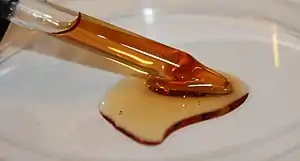α-Tocopherol
α-Tocopherol (alpha-tocopherol) is a type of vitamin E. Its E number is "E307". Vitamin E exists in eight different forms, four tocopherols and four tocotrienols. All feature a chromane ring, with a hydroxyl group that can donate a hydrogen atom to reduce free radicals and a hydrophobic side chain which allows for penetration into biological membranes. Compared to the others, α-tocopherol is preferentially absorbed and accumulated in humans.
 | |
 | |
 | |
| Names | |
|---|---|
| Preferred IUPAC name
(2R)-2,5,7,8-Tetramethyl-2-[(4R,8R)-4,8,12-trimethyltridecyl]-3,4-dihydro-2H-1-benzopyran-6-ol | |
| Identifiers | |
3D model (JSmol) |
|
| ChEBI | |
| ChEMBL | |
| ChemSpider | |
| DrugBank | |
| ECHA InfoCard | 100.000.375 |
| EC Number |
|
| E number | E307a (antioxidants, ...) |
PubChem CID |
|
| UNII | |
CompTox Dashboard (EPA) |
|
| |
| |
| Properties | |
| C29H50O2 | |
| Molar mass | 430.71 g/mol |
| Appearance | yellow-brown viscous liquid |
| Density | 0.950 g/cm3 |
| Melting point | 2.5 to 3.5 °C (36.5 to 38.3 °F; 275.6 to 276.6 K) |
| Boiling point | 200 to 220 °C (392 to 428 °F; 473 to 493 K) at 0.1 mmHg |
| insoluble | |
| Solubility | soluble in alcohol, ether, acetone, oils |
| Pharmacology | |
| A11HA03 (WHO) | |
| Hazards | |
| NFPA 704 (fire diamond) | |
Except where otherwise noted, data are given for materials in their standard state (at 25 °C [77 °F], 100 kPa).
Infobox references | |
Vitamin E is found in a variety of tissues, being lipid-soluble, and taken up by the body in a wide variety of ways. The most prevalent form, α-tocopherol, is involved in molecular, cellular, biochemical processes closely related to overall lipoprotein and lipid homeostasis. Ongoing research is believed to be "critical for manipulation of vitamin E homeostasis in a variety of oxidative stress-related disease conditions in humans."[2] One of these disease conditions is the α-tocopherol role in the use by malaria parasites to protect themselves from the highly oxidative environment in erythrocytes.[3]
Stereoisomers
α-Tocopherol has three stereocenters, so it is a chiral molecule.[4] The eight stereoisomers of α-tocopherol differ in the configuration of these stereocenters. RRR-α-tocopherol is the natural one.[5] The older name of RRR-α-tocopherol is d-α-tocopherol, but this d/l naming should no longer be used, because whether l-α-tocopherol should mean SSS enantiomer or the SRR diastereomer is not clear, from historical reasons. The SRR may be named 2-epi-α-tocopherol, the diastereomeric mixture of RRR-α-tocopherol and 2-epi-α-tocopherol may be called 2-ambo-α-tocopherol (formerly named dl-α-tocopherol). The mixture of all eight diastereomers is called all-rac-α-tocopherol.[6]
One IU of tocopherol is defined as 2⁄3 milligram of RRR-α-tocopherol (formerly named d-α-tocopherol). 1 IU is also defined as 0.9 mg of an equal mix of the eight stereoisomers, which is a racemic mixture, all-rac-α-tocopheryl acetate. This mix of stereoisomers is often called dl-α-tocopheryl acetate.[7] Starting with May 2016, the IU unit is made obsolete, such that 1 mg of "Vitamin E" is 1 mg of d-alpha-tocopherol or 2 mg of dl-alpha-tocopherol.[8]
References
- Merck Index, 11th Edition, 9931.
- Rigotti A (2007). "Absorption, transport, and tissue delivery of vitamin E". Molecular Aspects of Medicine. 28 (5–6): 423–36. doi:10.1016/j.mam.2007.01.002. PMID 17320165.
- Shichiri M, Ishida N, Hagihara Y, Yoshida Y, Kume A, Suzuki H (2019). "Probucol induces the generation of lipid peroxidation products in erythrocytes and plasma of male cynomolgus macaques". Journal of Clinical Biochemistry and Nutrition. 64 (2): 129–142. doi:10.3164/jcbn.18-7. PMC 6436040. PMID 30936625.
- Jensen SK, Lauridsen C (2007). "Alpha-tocopherol stereoisomers". Vitamins and Hormones. 76: 281–308. doi:10.1016/S0083-6729(07)76010-7. ISBN 9780123735928. PMID 17628178.
- Brigelius-Flohé R, Traber MG (July 1999). "Vitamin E: function and metabolism". FASEB Journal. 13 (10): 1145–55. doi:10.1096/fasebj.13.10.1145. PMID 10385606. S2CID 7031925.
- IUPAC Nomenclature of Tocopherols and Related Compounds, from https://www.degruyter.com/document/doi/10.1351/pac198254081507/pdf
- "Composition of Foods Raw, Processed, Prepared USDA National Nutrient Database for Standard Reference, Release 20" (PDF). USDA. February 2008. Archived from the original (PDF) on 2012-02-19.
- "Unit Conversions". National Institutes of Health. Retrieved 2018-11-21.
